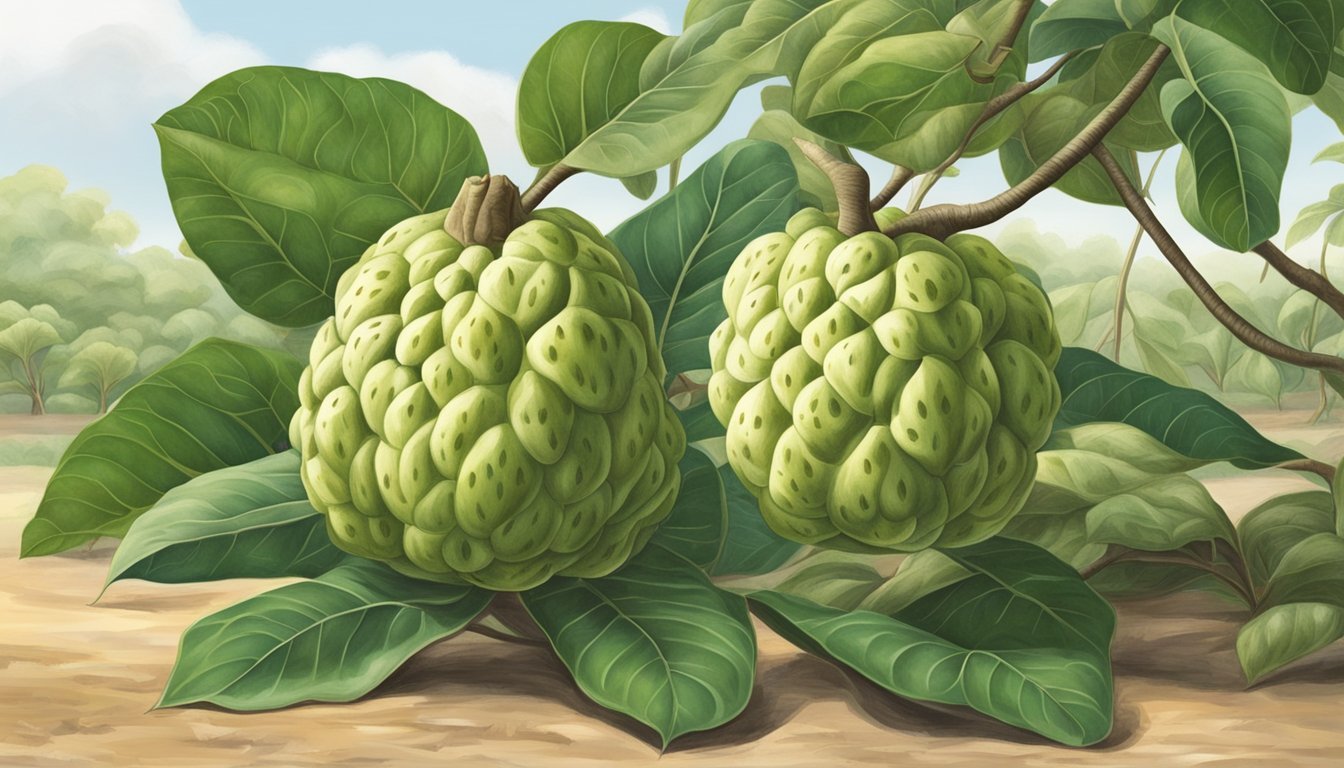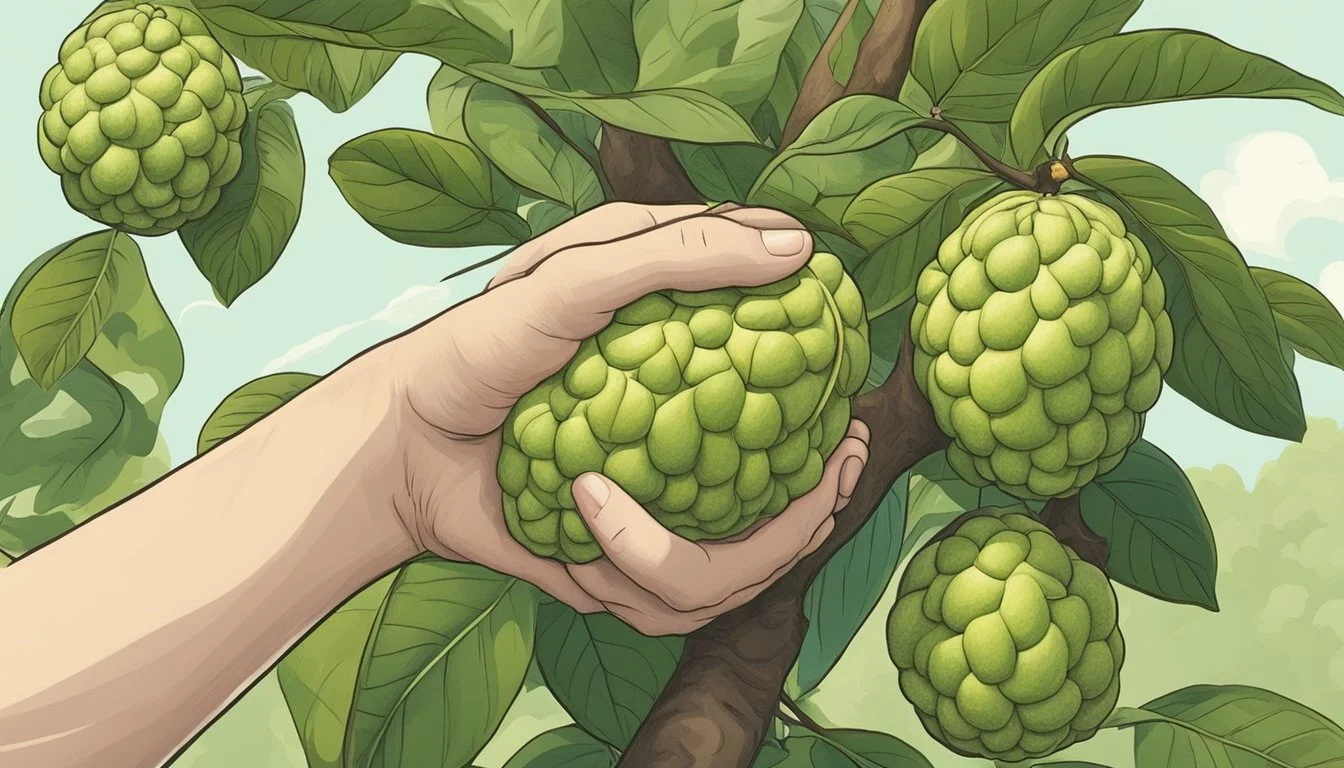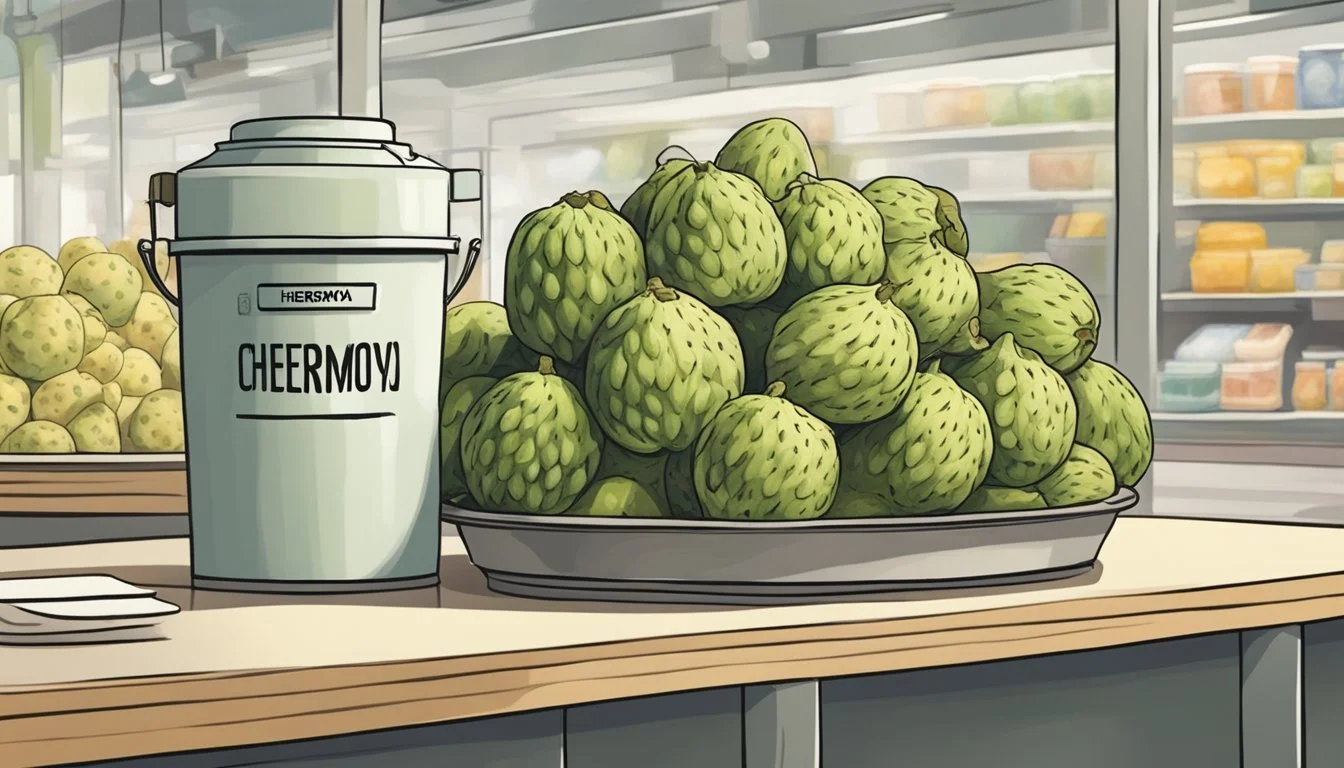How to Substitute Cherimoya for Custard Apple
A Simple Guide
Cherimoya and custard apple are two fruits often celebrated for their lush, creamy textures and sweet, tropical flavors. When looking for a substitute for cherimoya in recipes, custard apple proves to be a viable alternative given their similar taste profiles. While both are custard-like in consistency, cherimoya is typically creamier and slightly sweeter, with a heart-like shape and scaly greenish-brown skin. On the other hand, custard apple, with its bumpy green sack appearance, offers a similar flavor with a thicker and rougher skin.
Substituting one for the other in culinary applications requires an understanding of the nuances in texture and taste that each fruit brings to the dish. Cherimoya, containing about 17 grams of carbohydrates per 100 grams and just 0.7 grams of fat, offers a lower calorie content, due in part to its higher water content of 79.39g per 100g. Custard apple comes in slightly heavier with around 23 grams of carbohydrates and 0.6 grams of fat, along with a 71.5g water content per 100g. These differences are subtle but notable when aiming for a particular consistency or sweetness in a recipe.
In the pursuit of a suitable swap between these two fruits, culinary enthusiasts can confidently use them interchangeably in desserts, smoothies, and tropical dishes. Their flesh, while differing slightly in texture, contributes a similar exotic flair to beverages and sweet treats. When opting for custard apple as a replacement for cherimoya, one can adjust for sweetness or texture through slight alterations to the recipe, ensuring a delightful outcome that closely mirrors the intended flavor profile.
Cultivation and Origin
Understanding the cultivation practices and historical origins of cherimoya and custard apple is crucial for both consumers and growers. These fruits, though related, have distinct requirements and legacies that shape their use in substitution.
Cherimoya Cultivation
Cherimoya (Annona cherimola) thrives in subtropical climates where temperatures remain between 65 and 80 degrees Fahrenheit. Originating from the Andes of South America, the tree requires well-draining soil and prefers altitudes between 700 and 2,400 meters. It is a member of the Annonaceae family, cultivated for its biodiversity-rich, creamy-textured fruit. The cherimoya trees are typically shorter than custard apple trees and can grow from 19 to 32 feet in height, which is conducive for small-scale farming and gardens.
Soil Requirements: Well-draining, fertile soil with ample organic matter.
Climate: Subtropical, with moderate temperatures and limited frost risk.
Custard Apple Origins
The custard apple (Annona squamosa), also part of the Annonaceae family, is believed to hail from the West Indies and the tropical regions of the Americas. As a broadleaf evergreen, the custard apple tree contrasts with the deciduous nature of the cherimoya tree. Upon its discovery, it quickly spread to other parts of the world, including South Asia and Africa, where it has been integrated into local agriculture and cuisine.
Historical Spread: From the West Indies and tropical Americas to global cultivation.
Tree Characteristics: Broadleaf evergreen with a spread of up to 30 feet.
Each species, though sharing family ties, has adapted to its environment in ways that are unique, underscoring the diversity and adaptability of the Annonaceae family.
Nutritional Profile
When substituting cherimoya for custard apple, one should consider the nutritional nuances as they differ in vitamins, minerals, and caloric content. This profile will explore these nutritional aspects to aid in a beneficial substitution.
Vitamins and Minerals
Cherimoya and custard apple both contain ample vitamins and minerals essential for health. Cherimoya is notably high in vitamin C, vitamin B6, and folate whereas custard apple, though also a good source of vitamin C, contains higher levels of iron. Both fruits are rich in potassium and magnesium, which contribute to body functions such as muscle contractions and nerve signals.
Vitamin C: Custard apple is a richer source.
Iron: Present in higher amounts in custard apple.
Potassium: Found abundantly in both fruits.
Magnesium: Adequate levels present in both cherimoya and custard apple.
Health Implications of Nutrients
The nutrients found in cherimoya and custard apple have significant health implications. A diet rich in vitamin C supports immune function and skin health, while vitamin B6 and folate are vital for metabolism and red blood cell production. Iron is crucial in combating anemia. Potassium and magnesium intake can contribute to cardiovascular health. Both fruits are considered to hold antioxidant properties that can protect against oxidative stress.
Caloric Content and Dietary Fiber
Both fruits are low in calories, making them a suitable addition to a weight management diet. Cherimoya provides slightly fewer calories due to its higher water content. Dietary fiber in both fruits aids digestive health and may have a role in regulating blood sugar levels.
Calories: Cherimoya is lower in comparison to custard apple.
Dietary Fiber: Both contain beneficial fiber, with custard apple being slightly higher.
By understanding the nutritional profiles of cherimoya and custard apple, consumers can make informed choices when substituting one for the other.
Physical Characteristics
When substituting cherimoya for custard apple, it's important to consider the physical characteristics that affect their use in culinary applications. These characteristics are pivotal to ensuring that the substitute will provide a similar texture and aesthetic in the final dish.
Size and Appearance
Cherimoya and custard apple vary significantly in terms of size and appearance:
Cherimoya typically exhibits a heart-shaped form and can range in size from small to medium, measuring approximately 10-20 centimeters in length. Its skin is green with a smooth yet slightly textured surface.
In stark contrast, the custard apple is often larger, with a more bumpy and irregular profile, mirroring a bumpy green sack. Its appearance is characterized by thick and rough skin with a more pronounced olive-green shade.
Texture and Flesh
The internal texture and flesh of each fruit play a crucial role in the substitution process:
Cherimoya possesses a creamy texture and creamy white flesh that is known for its richness and flavor depth. The flesh is especially tender, which makes it easy to scoop out and use as a custard substitute.
Custard apple, though comparable, has white flesh that's slightly less creamy than cherimoya. It still retains a soft consistency, which allows it to fulfill a similar function in recipes where a smooth and custard-like texture is desired.
Taste Profile
In the context of substituting cherimoya for custard apple, it's vital to consider the nuanced differences in flavor and their implications for culinary applications.
Flavor Comparison
Cherimoya offers a unique flavor profile often described as a blend of various fruits, including banana, pineapple, pear, and strawberry, with a hint of vanilla. The fruit is sweet with a smooth, creamy texture that contributes to its rich taste.
On the other hand, custard apple is also sweet, but its taste is less complex than cherimoya. It has a mildly granular texture and a subtle flavor likened to a less concentrated custard apple taste without the mosaic of flavors cherimoya presents.
Culinary Uses
Cherimoya:
Ideal for blending into smoothies for a sweet and exotic flavor.
Can be used as a topping or mix-in for desserts where a smooth, creamy consistency is desired.
Custard Apple:
Commonly eaten fresh; works well as a sweet snack or in fruit salads.
Suitable for simple dessert recipes where a pronounced sweet taste is not overwhelming.
When substituting cherimoya in recipes calling for custard apple, the distinct sweet taste and unique flavors of cherimoya should be considered. It may enhance the dish's flavor profile or, conversely, overpower subtle flavors, depending on the recipe.
Health Benefits
Substituting cherimoya for custard apple in recipes can offer a range of health benefits, providing essential nutrients that contribute to digestive health, cardiovascular health, and immunity. These fruits share several beneficial properties, yet they come with their distinct advantages.
Digestive Health
Cherimoya and custard apple are both high in dietary fiber, aiding in the prevention of constipation and promoting a healthy digestive tract. The fiber content also helps with satiety, making them an excellent choice for weight management. Specifically, a serving of custard apple contains significant amounts of fiber, contributing to gut health.
Cardiovascular Health
Potassium is pivotal for maintaining proper heart health, and both fruits are good sources of this mineral. Potassium helps regulate blood pressure and is linked to a lower risk of stroke. Additionally, the vitamin C and antioxidants present in cherimoya are known to contribute to heart health by reducing inflammation and combating oxidative stress, which can lead to cardiovascular disease.
Cancer and Immunity Support
These tropical fruits are rich in compounds that can bolster the immune system. The antioxidants found in cherimoya, in particular, combat free radicals and may reduce the risk of cancer. They do this by protecting cells from oxidative damage. Both fruits also provide a host of vitamins and minerals, such as vitamin C, which supports immune function and acts as an anti-inflammatory. The iron in custard apples contributes to immunity as well, ensuring an adequate supply of oxygen to the body's tissues.
Substituting Cherimoya for Custard Apple
When replacing custard apple with cherimoya in culinary uses, one must consider both the similarities in usage and the specific differences in recipes. Cherimoya can effectively substitute for custard apple due to its comparable flavor and texture, yet slight adjustments may be needed.
Similarities in Usage
Cherimoya and custard apple, both being tropical fruits, share many culinary uses. They are primarily enjoyed for their sweet and creamy flesh, making them suitable for a variety of sweet applications. These fruits can be:
Eaten raw: Enjoyed as a fresh, exotic snack.
Salads: They make a sweet addition to fruit salads.
Desserts: Pureed or chopped for use in custards, fruit tarts, and other desserts.
Smoothies: Blended to add a tropical flavor to smoothies.
Ice creams: Incorporated in ice cream recipes for a rich, creamy texture.
Cocktails: Muddled or pureed to lend sweetness to tropical cocktails.
Differences in Recipes
While cherimoya and custard apple are interchangeable in many recipes, one should note the subtle differences to ensure the best outcome:
Texture: Cherimoya tends to have a less grainy texture compared to some varieties of custard apple, such as the sugar apple (sweetsop).
Size: Recipes may need slight adjustments in quantities as cherimoya can be larger.
Sweetness: Since cherimoya might be sweeter than some custard apples, reduce the amount of added sweeteners accordingly.
Water content: Cherimoya has a higher water content; one might need to balance the moisture levels in recipes like ice creams or smoothies.
Purchasing and Storage
In the context of substituting cherimoya for custard apple, it's important to be cognizant of how to properly purchase and store these exotic fruits to maintain their smooth, creamy texture.
Buying Guide
Cherimoya can be found at select grocery stores and farmers’ markets, primarily in areas where exotic fruits are prevalent. When buying cherimoya, one should look for fruit with a green skin that yields to gentle pressure, indicating ripeness. It should feel heavy for its size, which suggests a juicy and creamy interior. Avoid fruits with brown spots or cracks.
Custard Apple, similar to cherimoya, is also available in grocery stores and at farmers’ markets specializing in exotic produce. The appearance of a ripe custard apple is slightly softer to touch. The skin may have a more textured, bumpier feel than that of the cherimoya, and it should also be without any dark blemishes or splits.
Storage Tips
After purchasing, custard apples can be left to ripen at room temperature in a fruit bowl. To expedite the ripening process, one may place the custard apple in a paper bag with a banana, which can help it ripen within 24 hours due to the ethylene gas emitted by the banana. Once ripe, both cherimoya and custard apple can be stored in the refrigerator to extend their shelf life. It's crucial to consume them when they're at the peak of ripeness for the best flavor and consistency.
Environmental and Health Considerations
When substituting cherimoya for custard apple, one should consider the environmental impact of pesticide use and the contribution of these fruits to a balanced diet. Each fruit offers a distinct nutritional profile beneficial for health.
Pesticides and Organic Varieties
Table: Nutritional Comparison per 100g
Nutrient Cherimoya Custard Apple Calories Low Low Water 79.39g 71.5g Carbohydrates 17g 23g Fiber ~3g ~2.4g Protein ~1.57g ~2.1g Vitamin C High Higher Minerals (Potassium, Iron) Varies Varies Sodium Minimal Minimal Antioxidants Present Present
Cherimoya and custard apple both may be exposed to pesticides during cultivation. To minimize exposure, consumers can seek out organic varieties which are grown without synthetic pesticides, thus potentially offering greater health benefits and reducing environmental impact.
Eating for a Balanced Diet
Incorporating cherimoya or custard apple into a balanced diet contributes valuable nutrients. Both fruits offer high water content and are low in calories, which aids in maintaining healthy hydration levels without consuming excess energy. Their fiber content supports digestion and may help to lower cholesterol levels and reduce inflammation.
Vitamin C, abundant in custard apple, is essential for the immune system, and the antioxidants present in both fruits may neutralize harmful free radicals. Potassium contributes to cardiovascular health, while the low sodium content in these fruits makes them a heart-friendly choice. The proteins, although not significant sources, along with vitamins and minerals, round out their nutritional profile, making both fruits beneficial components of a balanced diet.








